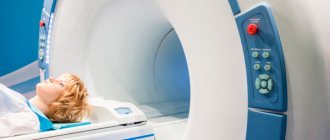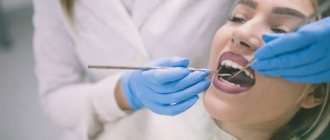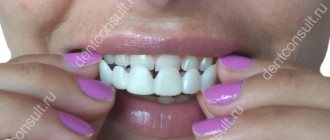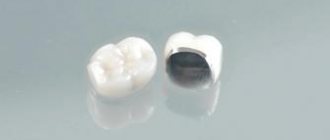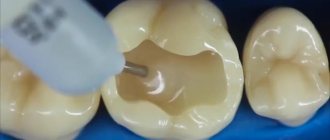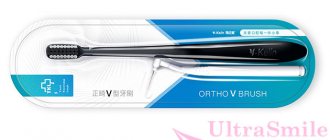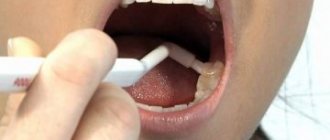How and with what means is tooth enamel whitening done?
You can whiten your teeth yourself only after visiting a dentist. This is due to the fact that the concentration of the bleaching agent in the preparation must be strictly individual and dependent on the actual state of the tooth enamel. Only a dentist can correctly determine it. This also applies to the duration of exposure of the drug to the enamel.
The bleaching agent in the preparation is carbamide peroxide. Its concentration in solution can range from 3% to 25%. The indicator depends on the degree of darkening of the enamel and on the desired color of the teeth after treatment.
To whiten enamel, it is not enough to simply coat it with a solution of carbamide peroxide. This drug still needs to be activated. This is done under the influence of light from a special lamp or under the influence of a laser beam.
The first option is much cheaper. Laser activation of the drug is significantly more expensive for obvious reasons, but the whitening is much more durable.
To obtain maximum results, you must undergo several procedures. These procedures can also be combined with home whitening method. In this case, the dentist gives the patient special devices - mouthguards. They are impregnated with a bleach solution of a given concentration. The trays are attached to the surface of the teeth and remain in the mouth for several hours. The duration of exposure of the trays to tooth enamel is determined by the dentist. The most convenient way to do home whitening is while you sleep.
Mouthguards are elastic strips that are tightly glued to the surface of the teeth. Unfortunately, these strips have a significant drawback. They cannot be used to whiten the spaces between teeth. The greatest effect from whitening can be obtained only by combining sessions at the dentist with home sessions.
Special gels are also available for home whitening. They are applied to the surface of the teeth with a brush, the bristles of which penetrate into the space between the teeth. The disadvantage of this remedy is that it takes too long to wait for the result. In this case, real whitening can be noticed only after a few weeks. Mouthguards are much more effective than gel or gel pencil.
The most effective are office procedures.
How to care for metal-ceramic teeth?
Metal-ceramic teeth, like real teeth, require careful care: if you want to keep them in their original form for a long time, do not forget about oral hygiene. You need to care for metal-ceramic teeth a little differently than for your “native” ones, but the basic principles remain almost the same: cleaning, removing plaque, limiting harmful influences, periodic consultations with the dentist. With proper care, your new teeth will serve you faithfully for many years.
And here’s how dentists recommend caring for metal-ceramic teeth:
You should brush your teeth not only in the morning and evening, but also after every meal. After eating, it is not necessary to use toothpaste and a brush every time, but you must rinse your mouth thoroughly and remove any remaining food with dental floss.
The choice of toothpaste and hard or soft brush is a matter of personal preference. For metal-ceramic teeth, these nuances are not as important as for real ones.
You need to brush your teeth with vertical movements directed from the gums to the edge of the tooth. Particular attention should be paid to the interdental spaces. The chewing surfaces of the teeth are cleaned in all directions with sweeping movements similar to the movements of a broom.
If metal-ceramic dentures are removable, it is recommended to initially remove them at night and store them cleaned in a dry box or in a special solution. Dentures should not be stored in water, remember this! The question of whether to remove dentures should be discussed with your doctor - he will recommend what would be best for you, based on the condition of the oral cavity, the type of denture and your age.
Easily digestible carbohydrates - sugar, chocolate, honey, cakes - are just as dangerous for teeth made of metal ceramics as for natural ones. Therefore, their use should be limited.
Do not chew hard objects - nuts, seeds, etc. This can lead to chipping of the ceramic enamel.
Smoking affects the color of metal-ceramic dentures, so people who smoke should use a special polish for metal-ceramics or contact a dentist to whiten their metal-ceramic teeth.
If you have a problem similar to that described in this article, be sure to contact our specialists. Don't diagnose yourself!
Why you should call us now:
- We will answer all your questions in 3 minutes
- Free consultation
- The average work experience of doctors is 12 years
- Convenient location of clinics
Single contact phone number: +7
Make an appointment
By the way, difficulties may arise with bleaching metal ceramics. Unfortunately, conventional bleaching agents are only effective on natural enamel, so using them is useless. And so that you don’t face the question of how to whiten metal-ceramic teeth, try to care for them properly, remove plaque on time and visit the dentist regularly.
Negative consequences after chemical whitening of tooth enamel
Everything that was said above applies to the chemical method of teeth whitening. It should be understood that in this case, tooth enamel is exposed to an aggressive substance, and this can lead to negative consequences.
One of them is demineralization of tooth enamel. The whitening solution not only washes away the dyes from the surface of the teeth, but also washes away the beneficial minerals contained in it. This increases the sensitivity of teeth to cold and heat. Even worse, excessively frequent chemical bleaching causes the enamel to become brittle. Microcracks may even appear in it.
The second threat from the chemical method is the possibility of loss of enamel shine. If trays or gel are used incorrectly, the enamel may become matte, that is, not a natural color.
Mechanical bleaching
The essence of the mechanical method of teeth whitening is to treat the enamel with water, which contains abrasive particles. Such water is supplied under high pressure through a special apparatus. It is understood that this is a purely professional method and it is impossible to apply it yourself. These particles remove coloring substances from the surface of the enamel and do not have a significant effect on the enamel itself. This ensures that the natural shine of the enamel is preserved.
Mechanical bleaching has another advantage. Abrasive particles crush tartar, and water washes them out of the mouth.
Mechanical teeth whitening is not associated with pain, provided that the patient does not have increased enamel sensitivity. If there is one, then you have to resort to anesthesia or whiten your teeth with ultrasound.
Unfortunately, this method is not suitable for people who drink too much coffee or strong black tea.
Teeth whitening with denture and crown
As we wrote earlier, changing the color of an already installed crown is extremely difficult, almost impossible, especially if the color does not match several tones at once. The best solution in such a situation would be to first carry out the whitening procedure, and only then select a ceramic or metal-ceramic crown that matches the color.
If you suspect that the teeth whitening procedure may be complicated, first of all you need to consult a specialist who will carefully examine your teeth and select the appropriate whitening treatment for healthy teeth, pulpless teeth, and artificial crowns. All this is possible and real, so there is nothing unnaturally difficult about it.
Make an appointment by calling 597-05-05 or using the online application form.
When to whiten teeth: before or after implantation?
Dentists, before installing fixed dentures or implanting an artificial root, always recommend teeth whitening, and there are two reasons for this.
Dental plaque and tartar harbor harmful bacteria. If both are not removed, these bacteria can penetrate the bone tissue during drilling for the implant and later cause an inflammatory process there.
It is also important that after teeth whitening, the dentist will be able to choose the right color for the crowns so that they do not stand out against the background of the dentition.
Whitening toothpastes
Whitening toothpastes contain abrasive microparticles. It is under their influence that coloring substances are removed from the surface of the enamel. At the same time, these particles cannot cause mechanical damage to the enamel itself, since the enamel is many times stronger than these particles. However, such pastes can only be used if there are no fixed dentures in the oral cavity.
Rough particles can create micro-scratches on the surface of dentures. Over time, bacteria accumulate in these scratches invisible to the eye, and then tartar forms. As a result, instead of whitening the dentures, the reverse process occurs.
We strongly recommend that people with fixed dentures use only regular toothpaste, not whitening toothpaste.
Classification and purpose
Based on the method of fastening, prosthetics are divided into the following types.
- Fixed. Dentures are attached to the mouth using specialized dental cements that connect the supporting structures to the crowns. Such structures (single, bridge, lumineers, etc.) are installed of course and are not removed by the patient throughout the entire use. Fixed prosthetics are required for single defects or defects in a row. Materials from which crowns are made: metal ceramics; metal; plastic/metal-plastic; composite (multicomponent materials, usually on a plastic basis) or metal composite.
- Removable. It is used in cases where the dentition is devoid of most of the teeth. Dentures can be partially or completely removable. Usually made from acrylic plastic (complex chemical substances obtained by polymerization of acrylic, methacrylic acids and their ester derivatives). The dentures are fixed mechanically using an exact fit of the base to the jaw structures or using a closing valve. Additional fixing mechanisms are used only to fix the prosthesis on the upper jaw, since the lower jaw is a component of the temporomandibular joint and actively moves. On the structures of the lower jaw, fixation occurs only with the help of mechanical retention, so it is possible to use additional adhesive pastes.
- Combined prosthetics is the use of products that combine elements of removable and fixed structures.
Some disadvantages associated with removable prosthetics should be noted. It is often necessary to replace the crowns of supporting healthy teeth. There may be temporary inconveniences in the form of impaired diction and gag reflex, which are associated with the volume of the base of the structure. Many patients feel the natural micro-movements of the clasp (part of a metal removable denture in the form of an arc that connects artificial dental structures). Removable dentures aggravate atrophic processes in the contacting tissues of the body, since the load also falls on healthy teeth, which play a supporting role for the dentures.
Important ! Progressive atrophy prevents further dental implantation.
There are also a number of contraindications to prosthetics:
- hyperreactivity to the material from which the prosthesis is made;
- bruxism of various etiologies (teeth grinding);
- the presence of inflammatory or carious changes at the installation sites;
- serious malocclusion (bite - the relationship of the teeth with maximum contact of the upper and lower rows during complete closure);
- short crowns of the tooth being prosthetized (a crown is a microprosthesis covering the coronal part of the tooth);
- increased wear and loosening of teeth.
Important ! Some contraindications are eliminated during thorough dental preparation before prosthetics.
Allergic reactions are least likely to be associated with dentures made from metal-free ceramics (all-ceramic, all-zirconium, zirconium with ceramic lining), however, such dentures are more fragile, so they should not be chewed on solid food (for example, nuts), and care for them, including from a hygienic point of view, should be more scrupulous.
